Partnership in Action
Advanced Molecular Detection (AMD): the Power of Innovation and Partnerships to Advance Public Health
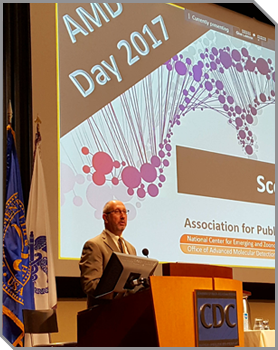
APHL Executive Director Scott Becker highlights the value of AMD in state & local labs
More than 400 external partners and CDC staff gathered in Atlanta as CDC and the Association of Public Health Laboratories (APHL) hosted the fourth annual AMD Day 2017 on September 25 and 26. This year, the event expanded to 2 days in order to cover all of the science. AMD combines powerful technologies (DNA sequencing and advanced computing) to solve complex infectious disease mysteries, ultimately saving lives and reducing costs. Since CDC’s Office of Advanced Molecular Detection was established in 2014, AMD has played a pivotal role in many areas of public health including
- identifying the genetic makeup of Ebola and Zika during each of those outbreaks
- solving foodborne outbreaks involving Listeria infection faster by linking food sources to clusters of illness
AMD Day brought together laboratory scientists, bioinformatics experts, and infectious disease epidemiologists to meet and discuss their success, challenges and future plans for the transformation of public health practice through AMD. The event featured remarks from CDC director Dr. Brenda Fitzgerald and APHL Executive Director Scott Becker. Staff from APHL, the Association of State and Territorial Health Officials, the American Society of Microbiology, the Council of State and Territorial Epidemiologists, biotechnology companies, as well as 60 participants from state and local health departments participated and enjoyed a robust program that ranged from the scientific to the programmatic, including
- a keynote address on the history of sequencing technologies as well as current trends in the industry
- interactive demonstrations, including a presentation on data visualization
- a panel presentation focusing on developing the public health workforce
- a panel describing the value of translating AMD science and successes for the public
In the next 3-5 years, AMD will continue to harness the power of next-generation sequencing and other technologies to address infectious disease threats. Specifically, AMD will help scientists
- prepare for future public health emergencies and emerging infectious diseases, as AMD did for Ebola virus and Zika virus
- continue the roll-out of technology to states and take measures to keep states up-to-date with rapidly evolving AMD technologies
- integrate genomic data with epidemiologic data to optimize public health impact
- continue the ramp-up of workforce transformation
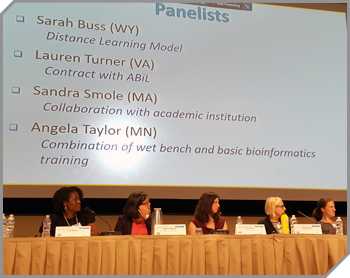
Public health lab staff from Wyoming, Virginia, Massachusetts & Minnesota provide state perspectives on AMD and workforce development
Next-generation sequencing and related technologies continue to advance at an astounding pace giving us new and expanded tools to detect disease faster, identify outbreaks sooner and protect people from emerging and evolving disease threats. To be successful and use these technologies to stay ahead of the next infectious disease threat, all levels of the public health system need to work together with AMD. AMD Day provided a unique opportunity for our partners to gather, learn and explore new and additional ways to collaborate in this rapidly changing field.
Partnering to Prevent Illnesses Shared Between People and Pets
 Did you know that 3 out of every 5 new human sicknesses come from bugs or other animals? Every year, tens of thousands of Americans will get sick from diseases spread between animals and people. These are known as zoonotic diseases, and CDC is always tracking and reporting these diseases to help people stay healthy.
Did you know that 3 out of every 5 new human sicknesses come from bugs or other animals? Every year, tens of thousands of Americans will get sick from diseases spread between animals and people. These are known as zoonotic diseases, and CDC is always tracking and reporting these diseases to help people stay healthy.
CDC’s One Health Office partners with physicians, veterinarians, ecologists, and many others to protect Americans by leading a public-private partnership to prevent diseases that are shared between people and their pets. This partnership of experts, called the Zoonoses Education Coalition, was formed to develop a set of evidence-based, plain language recommendations, which can be used by everyone to promote healthy pets and healthy people. The partnership has created messages to prevent infections like Salmonella, rat-bite fever, and lymphocytic choriomeningitis virus from reptiles and amphibians, pet rodents, or rodents used for pet food (feeder rodents). To this day, this partnership has resulted in scientifically based prevention messages to educate pet owners and other stakeholders on how to stay healthy while enjoying their pets.
Zoonoses Education Coalition Partners
- CDC
- Pet Industry Joint Advisory Council
- US Department of Agriculture (USDA)
- Food and Drug Administration (FDA)
- American Veterinary Medical Association (AVMA)
- National Association of State Public Health Veterinarians (NASPHV)
- Experts from the pet industry and breeders
Pets and other animals are a wonderful part of our lives, and safe and responsible pet ownership is important to keep both people and pets healthy and happy. By making sure that everyone is using the same messages regarding pet safety, pet owners and others can find the most reliable guidance about how to prevent illnesses and stay healthy while enjoying their pets.
NCEZID partners with CDC Foundation and Pfizer on cryptococcal screening in South Africa
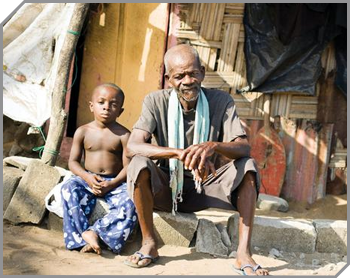 The National Center for Emerging and Zoonotic Infectious Diseases (NCEZID) and the CDC Foundation are using a grant from Pfizer to tackle cryptococcal meningitis (CM), a leading cause of death among people with HIV/AIDS. Through this partnership, screening strategies and costs are evaluated to provide policymakers and program implementers with the information they need to turn policy into action. Screening and pre-emptive treatment for early cryptococcal disease offers the opportunity to reduce burdens on health systems and to save lives. This partnership began in 2015 in South Africa and has helped the country finalize its strategy and implementation of national screening for early cryptococcal disease in October 2016.
The National Center for Emerging and Zoonotic Infectious Diseases (NCEZID) and the CDC Foundation are using a grant from Pfizer to tackle cryptococcal meningitis (CM), a leading cause of death among people with HIV/AIDS. Through this partnership, screening strategies and costs are evaluated to provide policymakers and program implementers with the information they need to turn policy into action. Screening and pre-emptive treatment for early cryptococcal disease offers the opportunity to reduce burdens on health systems and to save lives. This partnership began in 2015 in South Africa and has helped the country finalize its strategy and implementation of national screening for early cryptococcal disease in October 2016.
CM is a serious, fungal opportunistic infection that can attack patients with advanced HIV/AIDS. The condition requires hospitalization and treatment with amphotericin B, an intravenous antifungal medication. Annually, there are approximately 300,000 new cases worldwide. Sub-Saharan Africa has the highest number of estimated cases per year, followed by East, South, and Southeast Asia. In low-resource settings, with a lack of access to healthcare services, many patients with CM receive sub-optimal treatment. Patients often are not diagnosed early enough and do not receive care until the disease has advanced too far for treatment to be effective. Amphotericin B is very expensive or not available. Undetected, CM has been linked to increased deaths when patients with advanced HIV begin anti-retroviral treatment. One-third to one-half of all patients with CM will die from it.
A rapid dipstick test to diagnose cryptococcal disease, known as the Cryptococcal Antigen Lateral Flow Assay (CrAg LFA), was recently developed by fungal diagnostics manufacturer IMMY, based in Norman, Oklahoma. CrAg LFA is capable of detecting antigen in the blood weeks to months in advance of the onset of CM. This simple test requires minimal laboratory infrastructure and provides results in 10 minutes at a cost of $3-4 per person, offering significant advantages over traditional methods in resource-limited areas. CrAg LFA is highly accurate and can provide results quickly to inform treatment decisions, versus traditional tests that may miss positive cases and take weeks to return.
Early detection before meningitis develops means that patients can be treated with inexpensive pills that are readily available in low resource areas outside of a hospital, making this newer test an ideal screening tool. The World Health Organization has recommended CrAg LFA screening for patients with advanced HIV, and more than 20 countries have since included screening in national policy, though few have begun to implement screening programs. The successful evaluation in South Africa indicates that a similar approach could be expanded in other countries. Partnering together, CDC and the CDC Foundation will continue to provide ministries of health and HIV programs with the critical information needed to implement such programs, and to save lives through prevention and access to needed treatments.
CDC and BD Partner to Fight Zika
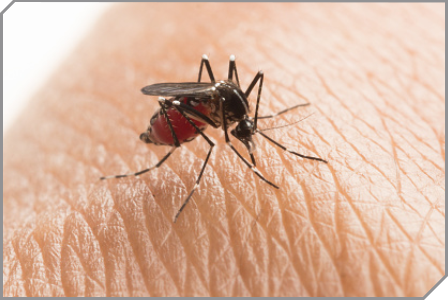 CDC’s Advanced Molecular Detection (AMD) Program is transforming disease detection and response through next-generation genomic sequencing and other advanced laboratory technologies. Partnerships are critical for implementing innovative AMD methods, which can produce cost-effective and reliable diagnostics and improve public health outcomes. As of October 2016, CDC is working with BD (Becton, Dickinson and Company) in Puerto Rico on a project to develop and validate diagnostic assays for Zika virus on the company’s BD MAX™ system, which is a complete, fully-automated, real-time molecular testing platform. By adapting and validating these molecular assays on this system, which is widely used in clinical labs throughout the world, CDC and BD hope to help translate these tests into routine diagnostic practice in a way that will benefit both industry and public health alike.
CDC’s Advanced Molecular Detection (AMD) Program is transforming disease detection and response through next-generation genomic sequencing and other advanced laboratory technologies. Partnerships are critical for implementing innovative AMD methods, which can produce cost-effective and reliable diagnostics and improve public health outcomes. As of October 2016, CDC is working with BD (Becton, Dickinson and Company) in Puerto Rico on a project to develop and validate diagnostic assays for Zika virus on the company’s BD MAX™ system, which is a complete, fully-automated, real-time molecular testing platform. By adapting and validating these molecular assays on this system, which is widely used in clinical labs throughout the world, CDC and BD hope to help translate these tests into routine diagnostic practice in a way that will benefit both industry and public health alike.
This collaboration is currently in the early stages, but the results are already showing promise. Since the BD MAX system was received and installed at CDC’s Puerto Rico laboratories in April 2016, preliminary testing using CDC’s existing Zika PCR assay already suggests that the results obtained by the system are equivalent to conventional testing on simulated samples, with a workflow that is much simpler and more automated. The next step in evaluating and validating the Zika assay on this platform is to begin testing on known positive and negative blood samples. The Zika virus diagnostic assay is one of several CDC-developed PCR assays that will be adapted to this platform, providing an important new set of standardized tools for clinical and public health testing. Through partnership with BD and other diagnostic vendors, CDC hopes to continue to use cutting-edge laboratory-developed tests for emerging infectious diseases and adapt them for routine clinical testing, improving the health of people throughout the world.
World leaders partner to combat antibiotic resistance
World leaders partner to combat antibiotic resistance
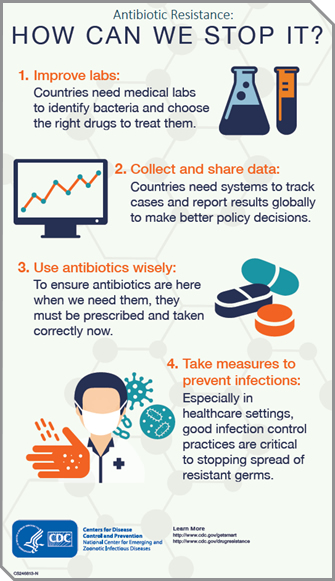 In September 2016, world leaders convened at the United Nations General Assembly in New York to discuss one of the biggest threats to global health—antibiotic resistance. All 193 member states signed on to combatting antibiotic resistance through a declaration to reverse the devastating trend that has resulted from the inappropriate use of antibiotics. Antibiotics and similar drugs, together called antimicrobial agents, have been used for the last 70 years to treat infectious diseases. Since the 1940s, these drugs have greatly reduced illness and death. They have been used so widely and for so long, however, that the infectious organisms the antibiotics are designed to kill have adapted to them, making the drugs less effective. Each year in the United States, antibiotic-resistant infections cause about 2 million illnesses and 23,000 deaths.
In September 2016, world leaders convened at the United Nations General Assembly in New York to discuss one of the biggest threats to global health—antibiotic resistance. All 193 member states signed on to combatting antibiotic resistance through a declaration to reverse the devastating trend that has resulted from the inappropriate use of antibiotics. Antibiotics and similar drugs, together called antimicrobial agents, have been used for the last 70 years to treat infectious diseases. Since the 1940s, these drugs have greatly reduced illness and death. They have been used so widely and for so long, however, that the infectious organisms the antibiotics are designed to kill have adapted to them, making the drugs less effective. Each year in the United States, antibiotic-resistant infections cause about 2 million illnesses and 23,000 deaths.
US Department of Health and Human Services Secretary Sylvia Matthews Burwell focused on solutions to the growing crisis by highlighting the critical role of prevention interventions including antibiotic stewardship, infection control, and vaccination. The World Bank presented predictions that, by 2050, antibiotic resistance could lead to a 5 percent loss in global GDP and result in 28 million more people in low-income countries pushed into poverty. US Centers for Disease Control and Prevention (CDC) Director Dr. Tom Frieden and leaders from CDC’s Office of Infectious Diseases and the National Center for Emerging and Zoonotic Infectious Diseases also met with world leaders at the General Assembly to echo and reinforce the importance of global action to fight antibiotic resistance and the threat it is posing to development goals, modern medicine, and food security.
Other partners, including pharmaceutical companies, signaled their commitment to fighting antibiotic resistance by pledging to reduce the environmental impacts of antibiotics while improving the access to and use of antibiotics by populations who need them most. Recognizing the complexity of the problem, world leaders, non-governmental organizations, pharmaceutical corporations, and public health organizations are joining forces to develop multifaceted solutions that will be required to combat the urgent and growing threat of antibiotic resistance.
To learn more about international activities to combat antibiotic resistance, visit https://www.cdc.gov/drugresistance/intl-actvities.html.
Healthier and safer in the water
The 2016 Model Aquatic Health Code (2nd Edition) helps make swimming and other water activities healthier and safer.
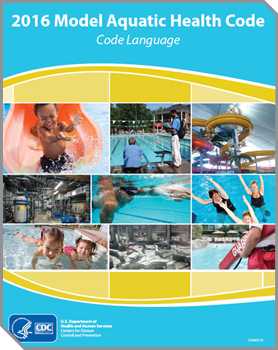 With temperatures soaring this summer, many Americans are heading to public pools and water playgrounds at waterparks, community rec centers, hotels/motels, and apartment/condo complexes to cool down. A partnership between CDC and the Council for the Model Aquatic Health Code (CMAHC) is helping make public aquatic venues healthier and safer for swimmers and aquatics staff.
With temperatures soaring this summer, many Americans are heading to public pools and water playgrounds at waterparks, community rec centers, hotels/motels, and apartment/condo complexes to cool down. A partnership between CDC and the Council for the Model Aquatic Health Code (CMAHC) is helping make public aquatic venues healthier and safer for swimmers and aquatics staff.
Promoting Health and Safety
The CMAHC was formed in 2013 to develop, promote, and update CDC’s Model Aquatic Health Code (MAHC). You might wonder what the MAHC has to do with pools and water, and how it keeps you and your family safe. It’s a voluntary set of guidelines based on science and best practices that help government agencies and the aquatics industry make swimming and other water activities healthier and safer. The guidelines include recommendations on how to best design, construct, operate, and maintain public aquatic venues.
The recommendations in the MAHC can help reduce the number of outbreaks of waterborne illnesses, drowning incidents, and injuries from pool chemicals and other causes. In the long run, this means the number of pools that are open, healthy, and safe goes up.
The 2016 Model Aquatic Health Code, 2nd Edition, released in July 2016, includes new and revised recommendations in the areas of disinfection and water quality, lifeguarding and bather supervision, risk management and safety, and ventilation and air quality.
Keeping Americans Safe through Strong Partnerships
 Government agencies and the aquatics industry now have the opportunity to voluntarily adopt the MAHC to help keep swimmers and aquatics staff safer and healthier, and it wouldn’t be possible without the CMAHC. The CMAHC brings together the combined expertise of public health professionals, the aquatics industry, and researchers across the U.S. to tackle water health and safety issues. It collects, assesses, and relays input on proposed MAHC revisions to CDC for consideration, ensuring that the MAHC is regularly improved and updated with the latest science, industry advances, and public health data. The CMAHC also develops materials to educate professionals and the public about the MAHC guidelines and provides technical assistance to health departments, boards of health, legislatures, and other partners on MAHC uses and benefits.
Government agencies and the aquatics industry now have the opportunity to voluntarily adopt the MAHC to help keep swimmers and aquatics staff safer and healthier, and it wouldn’t be possible without the CMAHC. The CMAHC brings together the combined expertise of public health professionals, the aquatics industry, and researchers across the U.S. to tackle water health and safety issues. It collects, assesses, and relays input on proposed MAHC revisions to CDC for consideration, ensuring that the MAHC is regularly improved and updated with the latest science, industry advances, and public health data. The CMAHC also develops materials to educate professionals and the public about the MAHC guidelines and provides technical assistance to health departments, boards of health, legislatures, and other partners on MAHC uses and benefits.
The CMAHC was instrumental in developing the 2nd edition of the MAHC, which strengthened the original guidelines. Like the first edition, the new edition ensures that a variety of perspectives, including those of experts working within the aquatic sector and at local and state public health agencies, were considered. The CMAHC’s strong partnership with CDC helps protect the public’s health while supporting healthy, safe, and cool summertime activities for everyone.
- Explore the MAHC website to check out the 2016 edition and supporting materials.
- Join the Council for the Model Aquatic Health Code, which collects and votes on proposed MAHC changes to recommend to CDC for final decision.
- Join the Network for the Model Aquatic Health Code, a community of MAHC users, subject matter experts, and those hoping to learn about the code (includes regular webinars).
Delivering a cure: Airline helps CDC save lives
 The Centers for Disease Control and Prevention (CDC), working closely with Delta Airlines and other key partners, helped three critically ill children in Haiti receive the lifesaving medication they needed within hours.
The Centers for Disease Control and Prevention (CDC), working closely with Delta Airlines and other key partners, helped three critically ill children in Haiti receive the lifesaving medication they needed within hours.
CDC maintains supplies of select drugs and other treatment products that are not commercially available, or are in limited supply. Some are stored at CDC Quarantine Stations located in major US airports, where they are ready for immediate shipment in the event of an emergency.
On February 27, 2015, CDC received an urgent request from the Ministry of Health in Port-au-Prince, Haiti, for diphtheria antitoxin—a product used to treat respiratory diphtheria, a life-threatening bacterial infection. Three siblings in Haiti had contracted the contagious disease, and likely wouldn’t survive without the medication. Another sibling had already died from the infection.
Typically, the treatment would be shipped on a cargo flight. However, the next available departure was 3 days away. Fortunately, one of Delta’s commercial jetliners was scheduled to leave from Atlanta for the Haitian capital later that day. CDC asked if Delta could take 20 vials of the treatment, enough for two of the children, aboard the flight. (The third child’s treatment was shipped from Miami via a different carrier.) It would be carried by the crew and then hand-delivered to medical personnel in Haiti.
 A CDC medical officer conferred with Delta and confirmed the shipment was in no way capable of transmitting illness, presenting zero infectious risk. The Transportation Security Administration also inspected and approved the treatment vials for shipment at the gate, and the plane was given the green light for departure. After the flight landed in Haiti, a CDC-Haiti medical epidemiologist met with the flight crew and delivered the medication to the hospital where all the children were being treated.
A CDC medical officer conferred with Delta and confirmed the shipment was in no way capable of transmitting illness, presenting zero infectious risk. The Transportation Security Administration also inspected and approved the treatment vials for shipment at the gate, and the plane was given the green light for departure. After the flight landed in Haiti, a CDC-Haiti medical epidemiologist met with the flight crew and delivered the medication to the hospital where all the children were being treated.
In such times of crisis, teamwork is critical. Thanks to their dedication and coordination, public and private partners working together helped save three children’s lives.
Turning human waste into affordable fuel in Kenya
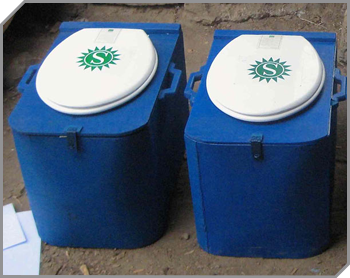 Have you ever stopped to think about how many times you use a toilet each day? We often take it for granted that when we “need to go,” a toilet will be nearby. However, throughout the world, an estimated 2.5 billion people do not have access to toilets or safe latrines. Without toilets or latrines, people have no other option than to relieve themselves on open land or in bodies of water. This can lead to contamination of a community’s drinking water source, making the water unsafe to drink.
Have you ever stopped to think about how many times you use a toilet each day? We often take it for granted that when we “need to go,” a toilet will be nearby. However, throughout the world, an estimated 2.5 billion people do not have access to toilets or safe latrines. Without toilets or latrines, people have no other option than to relieve themselves on open land or in bodies of water. This can lead to contamination of a community’s drinking water source, making the water unsafe to drink.
CDC is committed to increasing access to basic sanitation services, especially in under-developed countries where resources are limited. When a start-up group of recent university graduates approached CDC with an innovative idea—to provide toilets in households in need and use the human waste to make fuel briquettes—a new, collaborative partnership began.
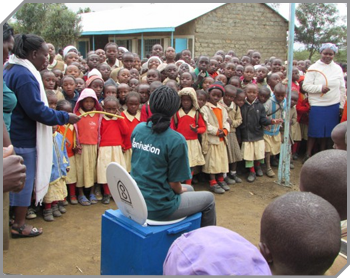 Established in 2011, Sanivation installs toilet facilities in Kenyan households for a small monthly service fee. The Sanivation representatives collect the waste, and treat it with solar thermal energy to create low-cost briquettes for cooking and heating homes. The briquettes burn longer than standard coal and may let off less particulates, leading to less pollution and better public health.
Established in 2011, Sanivation installs toilet facilities in Kenyan households for a small monthly service fee. The Sanivation representatives collect the waste, and treat it with solar thermal energy to create low-cost briquettes for cooking and heating homes. The briquettes burn longer than standard coal and may let off less particulates, leading to less pollution and better public health.
CDC first teamed up with Sanivation in 2013. With the support of a CDC Innovation Fund Award, CDC staff helped Sanivation examine how well and under what conditions (such as temperature and time) solar thermal treatment kills the harmful germs in human waste. After this first successful collaboration, CDC was able to support Sanivation with a supplemental award, which is being used to develop health and safety guidelines for workers employed in global waste collection, treatment, and reuse.
A future project CDC project with Sanivation will compare the effectiveness of composting toilets to solar sanitation in killing harmful germs in human waste. This is especially important when considering germs that are relatively heat-resistant, like the parasites Cryptosporidium and Ascaris Lumbricoides. Innovative partnerships such as this one are critical for CDC’s continuing work improving sanitation and hygiene services access across the globe.
Partnering with tribes to improve American Indian health
The Rocky Mountain spotted fever (RMSF) Rodeo project
 In 2003, a case of Rocky Mountain spotted fever (RMSF) was confirmed by the Centers for Disease Control and Prevention (CDC) as the cause of death of a 1-year-old American Indian child in Arizona in an area not previously known to have RMSF. A bacterial illness spread by the bite of an infected tick, RMSF can lead to death in more than 20% of cases when left untreated. Upon investigation, it was discovered that a new tick was spreading RMSF in Arizona. This tick–the brown dog tick–lives, eats, and breeds on dogs, bringing ticks out of the woods and into people’s homes. Cases in Arizona have reached epidemic proportions, with more than 300 cases and 20 deaths reported between 2002 and 2014. Children have been particularly affected, representing more than half of all cases and deaths from this terrible disease.
In 2003, a case of Rocky Mountain spotted fever (RMSF) was confirmed by the Centers for Disease Control and Prevention (CDC) as the cause of death of a 1-year-old American Indian child in Arizona in an area not previously known to have RMSF. A bacterial illness spread by the bite of an infected tick, RMSF can lead to death in more than 20% of cases when left untreated. Upon investigation, it was discovered that a new tick was spreading RMSF in Arizona. This tick–the brown dog tick–lives, eats, and breeds on dogs, bringing ticks out of the woods and into people’s homes. Cases in Arizona have reached epidemic proportions, with more than 300 cases and 20 deaths reported between 2002 and 2014. Children have been particularly affected, representing more than half of all cases and deaths from this terrible disease.
Because this type of tick lives in and around homes, prevention of RMSF had to go above and beyond bug spray and tick checks. CDC’s National Center for Emerging and Zoonotic Infectious Diseases (NCEZID) and the National Center for Environmental Health (NCEH) joined forces with tribal and local health departments, the Indian Health Service, Arizona Department of Health Services, and other public and private partners to design a new tick control strategy. A pilot project, the RMSF Rodeo, started in 2012 and used long-lasting tick collars on dogs, monthly environmental pesticide applications, and community-based education about tick control and pet health.
The RMSF Rodeo achieved rapid and dramatic control of tick populations–the number of dogs with ticks went from 63% to less than 1% in the first year, with efforts sustained in the second year with the tick collar alone. No deaths have occurred in the Rodeo community since the start of the projects, and cases in people have been reduced by 43%. Based on the overwhelming success of the initial RMSF Rodeo, the tribe decided to expand the key aspects of the project (including monthly pesticide application and use of the long-lasting collar) reservation-wide. The success has motivated other highly impacted tribes to implement similar prevention programs. Expansion of this prevention program is critical to continue to reduce the number of RMSF cases in people and save lives.
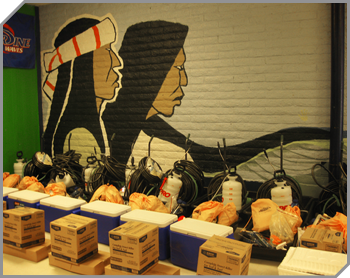 The Rodeo project serves as a model for other local communities seeking to reduce RMSF transmitted by the brown dog tick, and is now reaching across the US-Mexico border. In 2015, the government of Mexico declared RMSF to be a public health emergency. There have been a high number of cases reported, particularly among children, in some areas of Northern Mexico. NCEZID has formed collaborations with the Ministry of Health, state health departments, and academic institutions in Mexico to better define the burden of disease, increase diagnostic capacity, and create lasting prevention programs to reduce disability and death in Mexican communities.
The Rodeo project serves as a model for other local communities seeking to reduce RMSF transmitted by the brown dog tick, and is now reaching across the US-Mexico border. In 2015, the government of Mexico declared RMSF to be a public health emergency. There have been a high number of cases reported, particularly among children, in some areas of Northern Mexico. NCEZID has formed collaborations with the Ministry of Health, state health departments, and academic institutions in Mexico to better define the burden of disease, increase diagnostic capacity, and create lasting prevention programs to reduce disability and death in Mexican communities.
Protecting Travelers’ Health
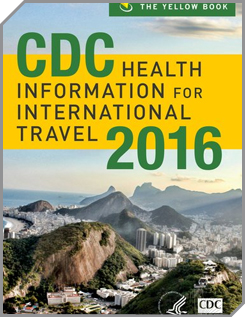 In the past decade, global travel has grown dramatically. Any traveler—human, animal, or pathogen—can cross the globe in less than 24 hours. Recent health events, such as the Ebola outbreak in West Africa and the spread of chikungunya in the Western Hemisphere, have piqued public interest in travelers’ safety and highlighted the importance of accurate, up-to-date travel health information.
In the past decade, global travel has grown dramatically. Any traveler—human, animal, or pathogen—can cross the globe in less than 24 hours. Recent health events, such as the Ebola outbreak in West Africa and the spread of chikungunya in the Western Hemisphere, have piqued public interest in travelers’ safety and highlighted the importance of accurate, up-to-date travel health information.
CDC Health Information for International Travel (more commonly known as the Yellow Book) is the definitive resource for preventing illness and injury in a globalized world. The book provides the U.S. government’s health recommendations for international travel, including vaccine and drug information, disease maps and country-specific disease information, and detailed precautions for specific types of travelers.
The Yellow Book is published biennially through a partnership between CDC’s Travelers’ Health Branch, the CDC Foundation, and Oxford University Press. Travelers’ Health coordinates a comprehensive update to the book’s content for each new edition. By working with hundreds of travel medicine experts, CDC provides the latest recommendations to protect the health of international travelers. Oxford provides technical expertise in layout, design, and marketing of the book. Oxford then publishes a hard copy version of the Yellow Book for sale, and CDC updates the free online version of the book. The Yellow Book is also available as an eBook and an app.
The new 2016 edition of the Yellow Book debuted in May 2015. To order a hard copy of the Yellow Book, visit Oxford University Press. To access an online version, view the Yellow Book table of contents. By partnering with Oxford and CDC Foundation, Travelers’ Health can continue to expand and improve Yellow Book content and provide a high-quality product in a variety of formats.
Promoting Antibiotic Stewardship
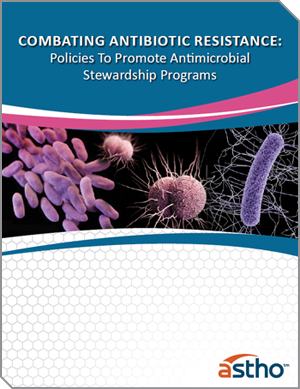 Responsible for over 2 million illnesses and 23,000 deaths annually in the United States, antibiotic resistance is one of the most pressing public health threats facing the world today. Infections from resistant bacteria are now too common, and some pathogens have even become resistant to multiple types or classes of antibiotics. As described in the recent CDC report, Antibiotic Resistant Threats in the United States, CDC, 2013 [PDF – 114 pages] , the consequences of inaction may be catastrophic. The report identifies 4 core actions to prevent the spread of antibiotic resistance, including antibiotic stewardship.
Responsible for over 2 million illnesses and 23,000 deaths annually in the United States, antibiotic resistance is one of the most pressing public health threats facing the world today. Infections from resistant bacteria are now too common, and some pathogens have even become resistant to multiple types or classes of antibiotics. As described in the recent CDC report, Antibiotic Resistant Threats in the United States, CDC, 2013 [PDF – 114 pages] , the consequences of inaction may be catastrophic. The report identifies 4 core actions to prevent the spread of antibiotic resistance, including antibiotic stewardship.
Careful, judicious stewardship of antibiotics can help to improve patient outcomes, prevent death from resistant infections, slow resistance, and reduce healthcare costs. A new Association of State and Territorial Health Officials ( ASTHO ) report, developed in partnership with CDC, Combating Antibiotic Resistance: Policies to Promote Antimicrobial Stewardship Programs , outlines approaches for state health agencies to tackle the antibiotic resistance challenge by:
• summarizing current state activities to address antibiotic resistance
• describing challenges to implementation identified through three pilot projects
• providing recommendations for successful stewardship programs in state health agencies
The report supports CDC’s Antibiotic Resistance Solutions Initiative, which provides a comprehensive approach to fulfilling CDC’s portion of the National Action Plan for Combating Antibiotic Resistant Bacteria . Partnerships like this are an important component of CDC’s efforts to strengthen public health capacities to address emerging health threats.
100 Partners Work to Promote Safe Injection Practices
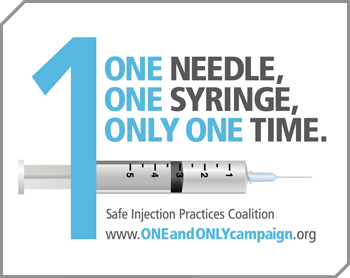
While battling a recurrence of breast cancer in 2000, Dr. Evelyn McKnight was infected with hepatitis C virus during her treatment at a local oncology clinic. In total, 99 patients receiving treatment from the same clinic became infected with hepatitis C virus, because their provider failed to follow safe injection practices.
Unfortunately, outbreaks like Dr. McKnight’s happen far too often. Since 2001, there have been at least 50 outbreaks of viral hepatitis or bacterial infections associated with unsafe injection practices in the United States, and this is believed to be the tip of the iceberg. Many of these lapses involved healthcare providers reusing syringes and contaminating medication vials that were then used on other patients. And sometimes, healthcare providers simply do not know or practice the correct injection safety techniques.
What can we do to make sure that the foundation of safe care is strengthened? Efforts to promote safe injection practices are underway. Led by CDC and the Safe Injection Practices Coalition, the One & Only Campaign aims to prevent infections by ensuring that every medical injection is a safe one.

The Campaign is made possible by a CDC Foundation partnership with Eli Lilly and Company. With this partnership, the Campaign communicates with healthcare providers about injection safety by disseminating messages and materials through its growing network of more than 100 participating organizations —a 200% increase in the number of collaborators in just 1 year, who disseminated nearly 100,000 Campaign materials in 2014.
The bottom line is that injection safety is about protecting patients from what could be life-threatening diseases like hepatitis B, hepatitis C, HIV, and other infections.
- Page last reviewed: October 6, 2017
- Page last updated: October 6, 2017
- Content source:
Centers for Disease Control and Prevention
National Center for Emerging and Zoonotic Infectious Diseases (NCEZID)


 ShareCompartir
ShareCompartir